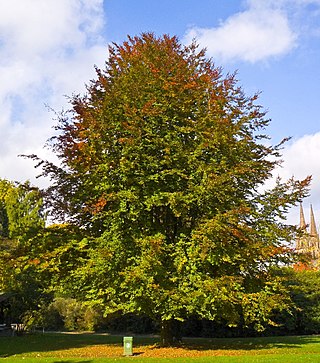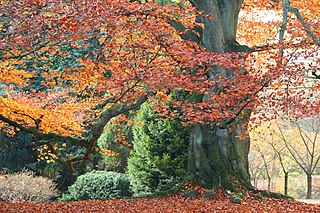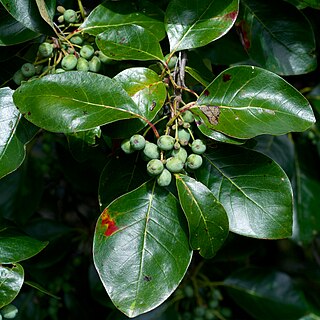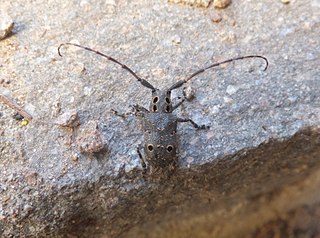
The Fagaceae are a family of flowering plants that includes beeches, chestnuts and oaks, and comprises eight genera with about 927 species. Fagaceae in temperate regions are mostly deciduous, whereas in the tropics, many species occur as evergreen trees and shrubs. They are characterized by alternate simple leaves with pinnate venation, unisexual flowers in the form of catkins, and fruit in the form of cup-like (cupule) nuts. Their leaves are often lobed and both petioles and stipules are generally present. Their fruits lack endosperm and lie in a scaly or spiny husk that may or may not enclose the entire nut, which may consist of one to seven seeds. In the oaks, genus Quercus, the fruit is a non-valved nut called an acorn. The husk of the acorn in most oaks only forms a cup in which the nut sits. Other members of the family have fully enclosed nuts. Fagaceae is one of the most ecologically important woody plant families in the Northern Hemisphere, as oaks form the backbone of temperate forest in North America, Europe, and Asia, and are one of the most significant sources of wildlife food.

Beech (Fagus) is a genus of deciduous trees in the family Fagaceae, native to temperate Europe, Asia, and North America. Recent classifications recognize 10 to 13 species in two distinct subgenera, Engleriana and Fagus. The Engleriana subgenus is found only in East Asia, distinctive for its low branches, often made up of several major trunks with yellowish bark. The better known Fagus subgenus beeches are high-branching with tall, stout trunks and smooth silver-grey bark. The European beech is the most commonly cultivated.

Nyssa sylvatica, commonly known as tupelo, black tupelo, black gum or sour gum, is a medium-sized deciduous tree native to eastern North America from the coastal Northeastern United States and southern Ontario south to central Florida and eastern Texas, as well as Mexico.

Fagus sylvatica, the European beech or common beech is a deciduous tree belonging to the beech family Fagaceae.

Fagus orientalis, commonly known as the Oriental beech, is a deciduous tree in the beech family Fagaceae. It is native to Eurasia, in Eastern Europe and Western Asia.
This article gives an overview of the woodland and scrub communities in the British National Vegetation Classification system.

The New Canaan Nature Center is a botanical garden, arboretum and nature preserve located at 144 Oenoke Ridge, Route 124, about .25 miles (0.40 km) north of the center of New Canaan, Connecticut.

King's Wood and Urchin Wood SSSI is a 128.1 hectare biological Site of Special Scientific Interest near the villages of Cleeve and Congresbury, North Somerset, notified in 1990.

Dorcus parallelipipedus, the lesser stag beetle, is a species of stag beetle found in Europe.
Phytophthora cambivora is a plant pathogen that causes ink disease in European chestnut trees. Ink disease, also caused by Phytophthora cinnamomi, is thought to have been present in Europe since the 18th century, and causes chestnut trees to wilt and die; major epidemics occurred during the 19th and 20th centuries. P. cinnamomi and P. cambivora are now present throughout Europe since the 1990s. Ink disease has resurged, often causing high mortality of trees, particularly in Portugal, Italy, and France. It has also been isolated from a number of different species since the 1990s, including:

Clytra laeviuscula, the ant bag beetle, is a species of short-horned leaf beetles belonging to the family Chrysomelidae, subfamily Cryptocephalinae.

Anaglyptus mysticus, the rufous-shouldered longhorn beetle, is a species of beetle belonging to the family Cerambycidae, subfamily Cerambycinae.

Chlorophorus sartor is a species of beetle of the family Cerambycidae, subfamily Cerambycinae.

Rutpela maculata, the spotted longhorn, is a beetle species of flower longhorns of the family Cerambycidae, subfamily Lepturinae.
Stictoleptura erythroptera is a species of longhorn beetle in the Lepturinae subfamily. It was described by Jacob Johann Hagenbach in 1822 and can be found in Central and Western Europe,. The species can also be found in Eastern European countries like Bulgaria and Romania. It can also be found in Anatolia, the Caucasus and Iran.

Fagus × taurica, the Crimean beech, is a deciduous tree in the beech genus Fagus. The Balkan beechFagus moesiaca is considered to be the same species. It has been thought to be a hybrid between F. orientalis and F. sylvatica, but the relationships between Eurasian beeches are still unclear, and it may show greater affinity with F. orientalis.

Athous vittatus is a species of beetle in the family Elateridae and the genus Athous.

Buprestis rufipes, the red-legged buprestis, is a green metallic wood boring beetle native to southern and eastern United States in North America. Little is known about this beetle. It apparently inhabits dead or dying hardwood in its adult phase.

Mesosa curculionoides is a species of beetle in the family Cerambycidae, and the type species of its genus. It was described by Carl Linnaeus in 1761, originally under the genus Cerambyx. It has a wide distribution throughout Europe and in the Caucasus, and is also known from South Korea. It was formerly found in Belgium, where it is now extinct. It measures between 10 to 17 mm.

Elater ferrugineus, the rusty click beetle, is a species of click beetle belonging to the family Elateridae.



















